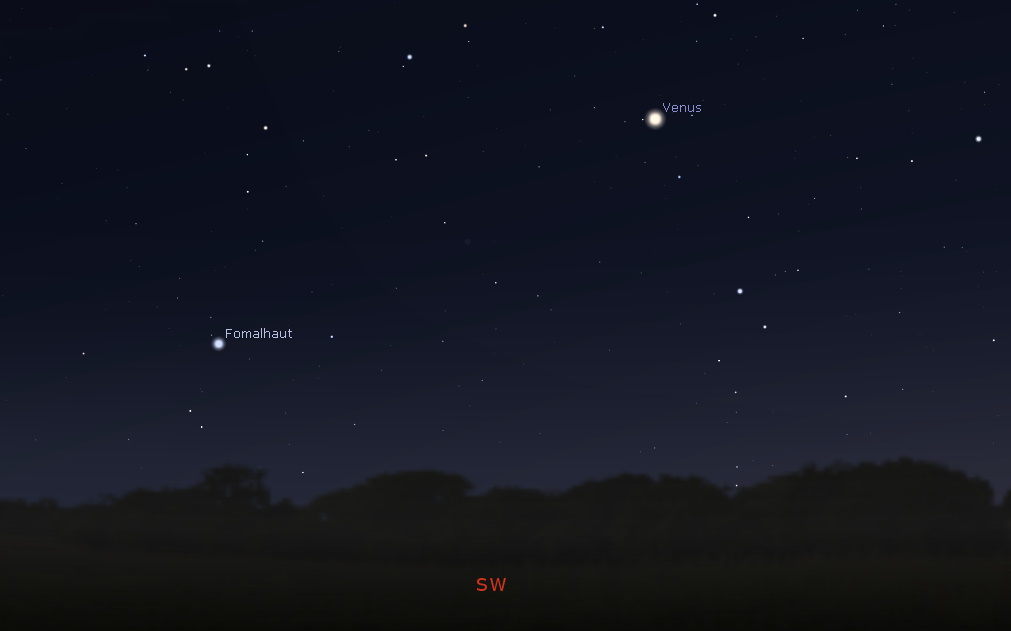
We’re running a membership drive this month – our goal is 150 new members. Please subscribe and help support this website and VOF education and outreach programs.
[maxbutton name=”Long Subscribe”]

Mars appears near the star Antares in the southeastern horizon before dawn this week; a waning crescent Moon joins them on January 20th.
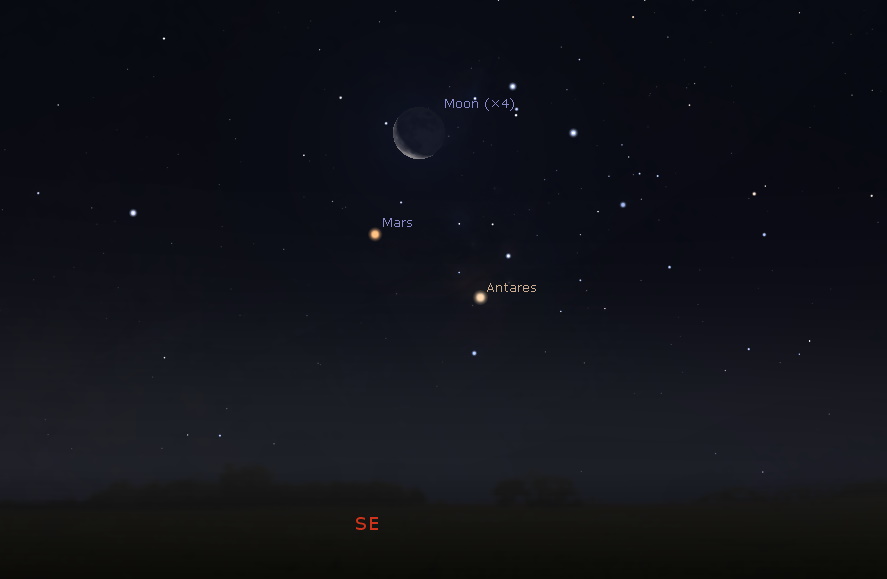 The Moon appears near Mars and the star Antares in the southeastern sky before sunrise on Jan. 20th. Credit: Stellarium / Bob Trembley.
The Moon appears near Mars and the star Antares in the southeastern sky before sunrise on Jan. 20th. Credit: Stellarium / Bob Trembley.The Moon appears near the star Regulus at midnight on January 13th, and near the star Spica on January 17th.
Venus appears high and bright above the southwestern horizon at dusk this week.

The Moon is a waning gibbous, rising after sunset, visible high in the sky after midnight, and visible to the southwest after sunrise.
The third quarter moon occurs on January 17th, rising around midnight, and visible to the south after sunrise.
After January 17th, the Moon will be a waning crescent, visible low to the east before sunrise.
 The Moon from 2020-01-14 – 2020-01-20. Visualizations by Ernie Wright / NASA’s Scientific Visualization Studio.
The Moon from 2020-01-14 – 2020-01-20. Visualizations by Ernie Wright / NASA’s Scientific Visualization Studio.Moon News

The Sun has been spot-free for 3 days; coronal holes appear at both poles, and a large coronal holes appears north of the equator.
The Sun seen in 193 angstroms (extreme ultraviolet) Jan. 13, 2020:
Light prominence activity over the last couple days – except for that large prominence in the upper right side of the video below:
The Sun seen in 304 angstroms (extreme ultraviolet) Jan. 13, 2020:
You can view the Sun in near real-time, in multiple frequencies here: SDO-The Sun Now.
You can create your own time-lapse movies of the Sun here: AIA/HMI Browse Data.
You can browse all the SDO images of the Sun from 2010 to the present here: Browse SDO archive.
Facebook: SolarActivity
https://www.facebook.com/photo.php?fbid=10220909573229991&set=gm.2915118168499508&type=3&theater&ifg=1
Solar Corona
Solar wind speed is 299.5 km/sec (↓↓), with a density of 0.4 protons/cm3 (↓↓) at 1100 UT.
Near real-time animation of the corona and solar wind from the Solar & Heliospheric Observatory (SOHO):
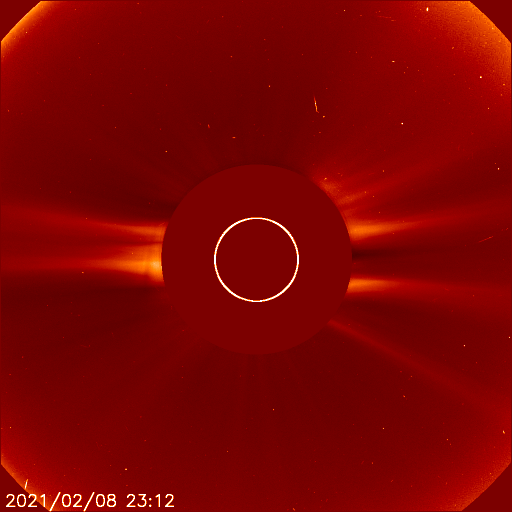 Animated LASCO C2 Coronograph showing the solar corona above the Sun’s limb (the white circle). Credit: NASA/JPL-Caltech-SOHO
Animated LASCO C2 Coronograph showing the solar corona above the Sun’s limb (the white circle). Credit: NASA/JPL-Caltech-SOHOSun News

Potentially hazardous asteroids: 2018 (last updated Oct. 1, 2019)
Total Minor Planets discovered: 921,902 (+8,850)
Upcoming Earth-asteroid encounters:
| Asteroid |
Date(UT)
|
Miss Distance
|
Velocity (km/s)
|
Diameter (m)
|
| 2020 AO |
2020-Jan-14
|
9.3 LD
|
19.5
|
49
|
| 2011 EP51 |
2020-Jan-15
|
19.6 LD
|
7.1
|
32
|
| 2017 RZ15 |
2020-Jan-15
|
12.1 LD
|
7.4
|
14
|
| 2020 AZ1 |
2020-Jan-16
|
8.3 LD
|
4
|
17
|
| 2019 YD3 |
2020-Jan-16
|
6.9 LD
|
4.8
|
22
|
| 2010 AE30 |
2020-Jan-17
|
11.9 LD
|
12.3
|
68
|
| 2019 YG1 |
2020-Jan-17
|
17.5 LD
|
4.5
|
32
|
| 2019 YQ3 |
2020-Jan-17
|
18.2 LD
|
3.1
|
19
|
| 2020 AD1 |
2020-Jan-17
|
9.1 LD
|
4.5
|
20
|
| 2020 AH1 |
2020-Jan-18
|
15.9 LD
|
8
|
45
|
| 2009 BH2 |
2020-Jan-18
|
14.6 LD
|
17.9
|
118
|
| 2019 YA5 |
2020-Jan-19
|
11.7 LD
|
5.2
|
22
|
| 2020 AQ1 |
2020-Jan-20
|
10.6 LD
|
27.6
|
135
|
| 2013 DU |
2020-Jan-20
|
14.9 LD
|
6.4
|
56
|
| 2019 TF2 |
2020-Jan-23
|
16.2 LD
|
1.6
|
19
|
| 2018 BM5 |
2020-Jan-23
|
13.1 LD
|
8.6
|
12
|
| 2018 AL12 |
2020-Jan-30
|
18.2 LD
|
17.7
|
39
|
| 2017 AE5 |
2020-Feb-01
|
13.6 LD
|
9
|
123
|
| 2018 BU1 |
2020-Feb-02
|
19.4 LD
|
10
|
41
|
| 163373 |
2020-Feb-15
|
15.1 LD
|
15.2
|
589
|
| 2018 CW2 |
2020-Feb-17
|
6 LD
|
10.2
|
28
|
| 2019 BE5 |
2020-Feb-20
|
13.9 LD
|
14.8
|
34
|
| 2011 DR |
2020-Feb-23
|
14.7 LD
|
5.8
|
25
|
| 2016 CO246 |
2020-Feb-23
|
18.4 LD
|
5.9
|
25
|
| 2012 DS30 |
2020-Feb-26
|
12.3 LD
|
5.4
|
22
|
| 2015 BK509 |
2020-Feb-28
|
18.3 LD
|
12.5
|
118
|
| 2017 BM123 |
2020-Mar-01
|
10.5 LD
|
8.1
|
65
|
| 2018 RF6 |
2020-Mar-10
|
11.2 LD
|
12.6
|
36
|
| 2008 UB95 |
2020-Mar-11
|
18.5 LD
|
7.6
|
41
|
Notes: LD means “Lunar Distance.” 1 LD = 384,401 km, the distance between Earth and the Moon. Red highlighted entries are asteroids that either pass very close, or very large with high relative velocities to the Earth. Table from SpaceWeather.com
Asteroid News
 On Jan. 13, 2020, the NASA All Sky Fireball Network reported 10 fireballs.
On Jan. 13, 2020, the NASA All Sky Fireball Network reported 10 fireballs.
(9 sporadics, 1 beta Sextantid)
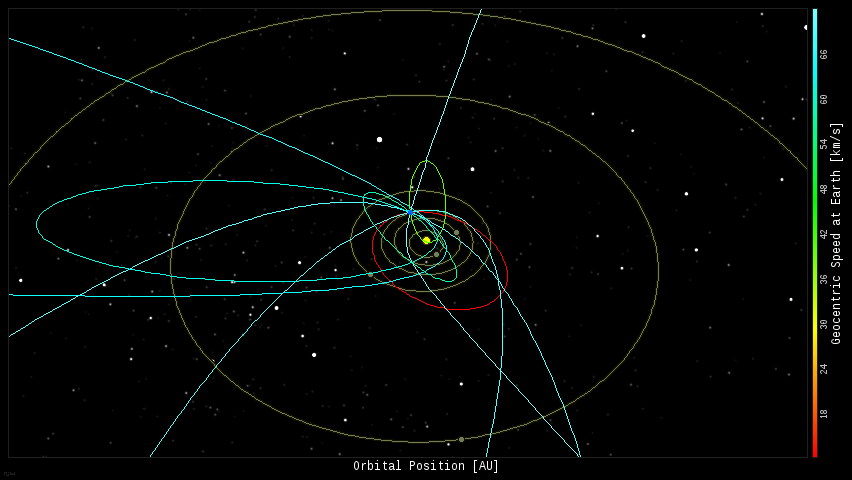 In this diagram of the inner solar system, all of the fireball orbits intersect at a single point–Earth. The orbits are color-coded by velocity, from slow (red) to fast (blue). From: Spaceweather.com
In this diagram of the inner solar system, all of the fireball orbits intersect at a single point–Earth. The orbits are color-coded by velocity, from slow (red) to fast (blue). From: Spaceweather.comFireball News
 Position of the planets and a couple spacecraft in the inner solar system:
Position of the planets and a couple spacecraft in the inner solar system:
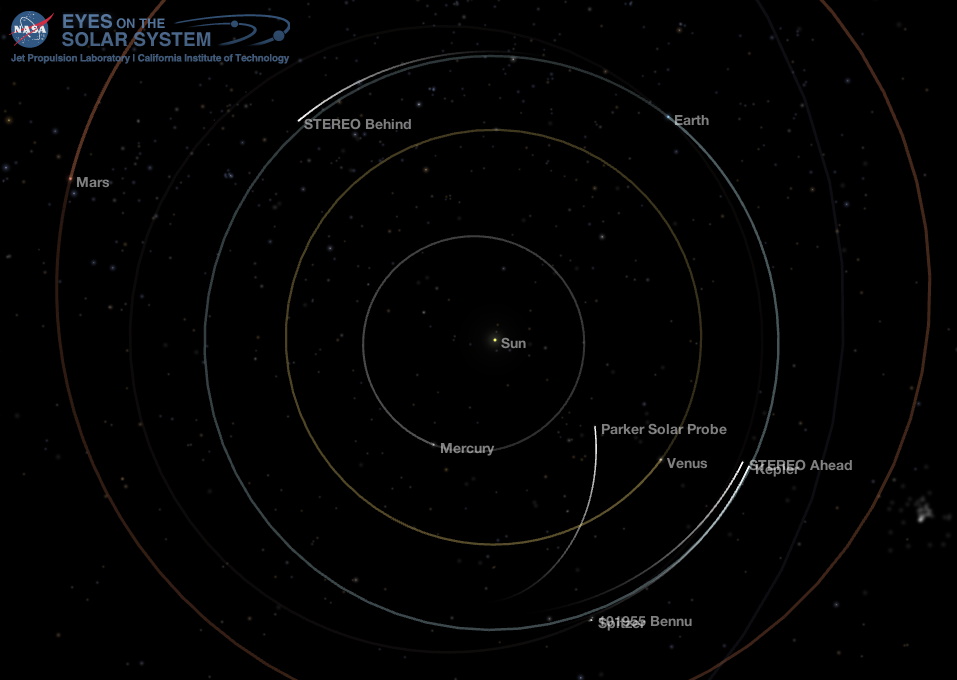 Position of the planets and a couple spacecraft in the inner solar system, 2020-01-14. Credit: NASA Eyes on the Solar System / Bob Trembley.
Position of the planets and a couple spacecraft in the inner solar system, 2020-01-14. Credit: NASA Eyes on the Solar System / Bob Trembley.Mars News: New Crater Candidate
Position of the planets and a couple bodies in the middle solar system:
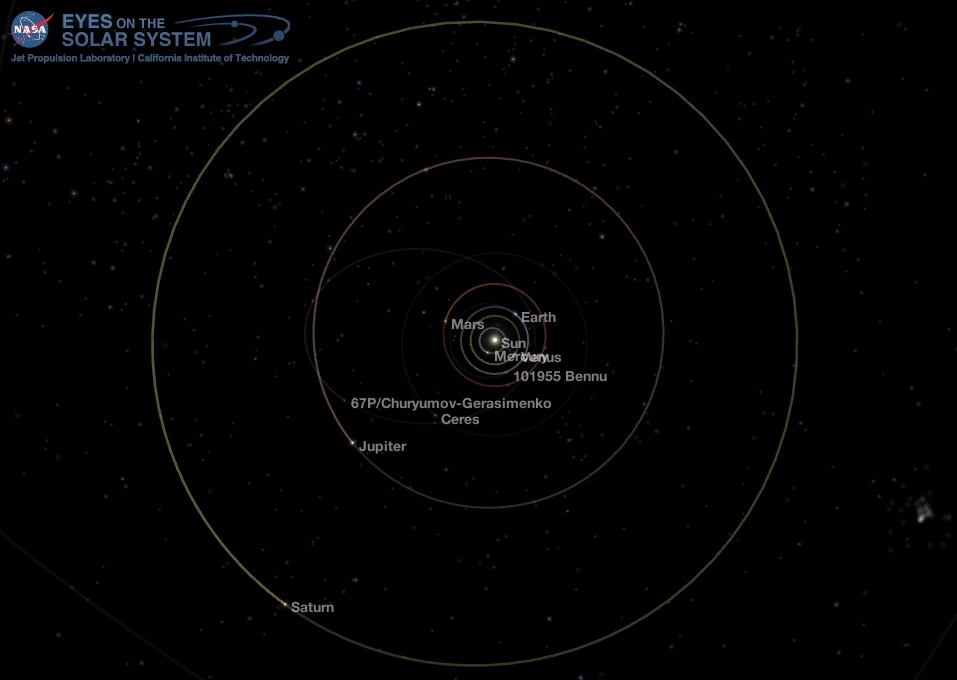 Position of the planets in the middle solar system, 2020-01-14. Credit: NASA Eyes on the Solar System / Bob Trembley.
Position of the planets in the middle solar system, 2020-01-14. Credit: NASA Eyes on the Solar System / Bob Trembley.Jupiter News: Amazing Citizen Scientist Image Processing!
https://twitter.com/universal_sci/status/1216884532688949249
Position of the planets in the outer solar system – the orbit of transneptunian object (38083) Rhadamanthus is highlighted:
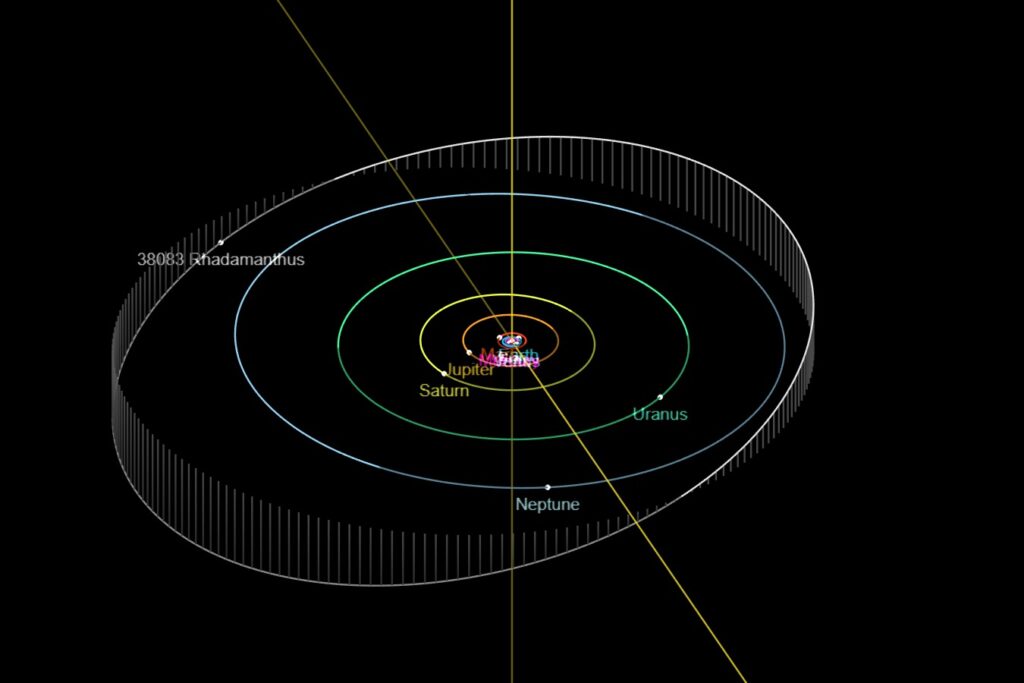 Outer Solar System 2020-01-14 – Orbit of transneptunian object (38083) Rhadamanthus is highlighted – vertical lines show distance above and below the plane of the ecliptic. Credit: JPL Small Body Database Browser / Bob Trembley.
Outer Solar System 2020-01-14 – Orbit of transneptunian object (38083) Rhadamanthus is highlighted – vertical lines show distance above and below the plane of the ecliptic. Credit: JPL Small Body Database Browser / Bob Trembley.(38083) Rhadamanthus
38083 Rhadamanthus is a trans-Neptunian object (TNO). It was discovered in 1999 by the Deep Ecliptic Survey. It was originally thought to be a plutino but no longer is.
Rhadamanthus was discovered on 17 April 1999 by the Deep Ecliptic Survey.
Rhadamanthus is named after the Greek mythological figure. The name was announced in the circular of the Minor Planet Center of 24 July 2002, which stated “Rhadamanthus was a son of Zeus and Europa. Because of his just and upright life, after death he was appointed a judge of the dead and the ruler of Elysium, a blissfully beautiful area of the Underworld where those favored by the gods spent their life after death. The name was suggested by E. K. Elliot. – Wikipedia
NASA’s Interactive Real-Time Web-based Orrery:
[iframe src=’https://eyes.nasa.gov/apps/orrery/’ height=600 percent=100 style=””]
OSIRIS-REx Asteroid Sample Return Mission
International Space Station: Spacewalk Tomorrow
Transiting Exoplanet Survey Satellite (TESS)
Man! I have GOT to attend some of these conferences!
Hubble Space Telescope: 30 Years!
ASTERIA Cubesat: Goes Silent
Climate: Arctic Sea Ice Decline Animation
Source: Annual Arctic Sea Ice Minimum 1979-2019 with Area Graph
| All Exoplanets | 4104 |
| Confirmed Planets with Kepler Light Curves for Stellar Host | 2356 |
| Confirmed Planets Discovered by Kepler | 2347 |
| Kepler Project Candidates Yet To Be Confirmed | 2420 |
| Confirmed Planets with K2 Light Curves for Stellar Host | 425 |
| Confirmed Planets Discovered by K2 | 392 |
| K2 Candidates Yet To Be Confirmed | 892 |
| Confirmed Planets Discovered by TESS | 37 |
| TESS Project Candidates | 1517 |
| TESS Candidates Yet To Be Confirmed | 1050 (-11) |
